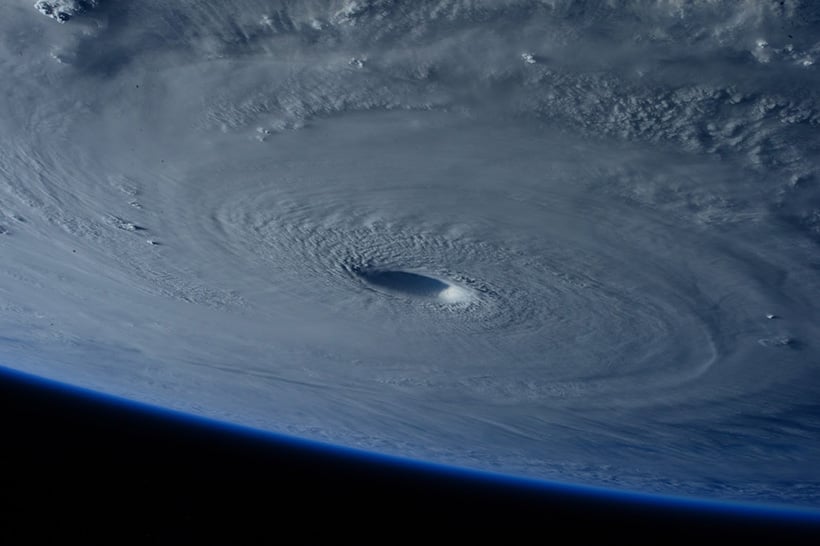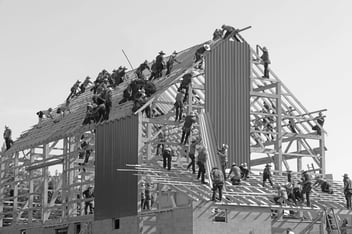At the very moment construction is being asked to digitally transform, accelerate urbanisation in the global south, and help the world transition to a net zero economy, it’s facing mounting weather risk...

Climate Change
Climate change is in action right now, with the most shocking and visible effects being the increasing weather variability and extremity (IPCC). Where there was once predictable rains, there are intermittent floods and droughts. Where there was once a peaceful coastline, there is now growing storm surge risk, amongst a long list of other concerns.
A report from the UN looked into the trends globally (1980-99 vs 2000-19) and they are worrying.
- Major floods have more than doubled in frequency.
- The number of severe storms has risen by 40%.
- Significant increases in droughts, wildfires and heatwaves have occurred.
The economic impact of all weather events collectively between 2000-2019 was $2.97 trillion, with a shocking 1.23 million killed, and 4.03 billion affected. All this with little more than 1°C of average global temperature increase since 1880. The worst is yet to come.

Impact on the sector
This presents a huge number of risks for the construction sector to deal with now and in the coming years. The following is an overview of the increased risks the industry will encounter due to weather:
Physical Risks:
Extreme weather events will undoubtedly see more damage to construction sites, such as heavy rainfall impacting excavation works with possibly knock on effects of a flooded site.
Project Risks:
Weather already delays projects, but with this risk rising some companies may choose to ignore it to stay cost competitive and pay for it later. It can be assumed that the number of projects losing profit due to weather will grow, unless the industry has a serious wake up call.
Administrative Risks:
Standards for buildings are likely to change which could lead to staff retraining and changes in decade long practices. If people and organisations can’t adapt then they could fall by the wayside in a rapidly changing world.
Liability Risks:
With increasing standards, and dynamic changing expectations of how risk should be managed there is likely to be an increase in litigation at management level. If managers don’t take weather risk seriously and then see large losses because of weather, clients may turn to management to say this is something they should have mitigated more effectively.
Health & Safety Risks:
Extreme heat and other extreme events will place undue stress on worker health, businesses will need to be conscious of this to avoid negative physical and mental health impacts on their workforce.
Operational Risks:
Today the industry has very little in the way of weather risk management, this has costs today but those are likely to balloon in future if no further action is taken. Even today, if companies fail to adopt new tools to manage construction weather risk they could be faced with decreasing competitiveness as others realise the need and opportunity for improvement.
Insurance Risks:
With trends all moving in the wrong direction premiums could rise or some risks or geographies may simply become uninsurable. This could see costs rising or some projects becoming uneconomical. To the previous point, growing insurance risk may accelerate adoption of new streamlined risk management tools to help counteract the rising cost of premiums.
Supply Chain Risks:
The construction industry sees the delivery of materials pour in from across the globe. The availability of these materials are reliant on stable sea trade and of stable conditions in the countries of origin. This is by no means guaranteed and could cause spikes in materials prices at precisely the wrong time.
Pressures of growth and transition
All those risks are bad enough, but when you couple them with the other pressures faced by the industry it paints a challenging picture. The industry is facing enormous pressure to digitise and upgrade so as to remain competitive and attract the right talent, seeing as the workforce, at least in the UK, is ageing. The industry is being asked to move on from traditional energy infrastructure to renewable forms of electricity production. This carries a burden on the industry to adapt and change. Many areas of the world are still rapidly urbanising and developing, with many of these regions lying in areas where weather risk impact on construction sites is greatest.

Risking the perfect storm
When pooling these risks together it can seem like the perfect storm. The pressure to change in a myriad of ways is a challenge for any business, but the construction sector is further hamstrung by low margins. This presents the final challenge of how these various transitions happen without significant investment. That does not mean it cannot and will not happen, it will just happen perhaps more slowly than would be preferable.
So what next?
Technology is by no means a silver bullet, but there are a number of ways where win-win scenarios can play out to help reduce climate risk and help the sector transition.
For example, with the advent of the world's first smart contract technology in construction and the maturing of parametric insurance offerings in the sector, sophisticated risk management packages can be put in place to optimise, automate and cap the cost of extreme weather risk. This gives Client, Contractor and Insurer a way to build a level of cost certainty into their contracts whilst removing the admin burden and possible causes of dispute.
Better data and planning tools offer a way for these risks to be measured and understood which is always the first step to managing and mitigating.
If you want to read more about the EHAB weather risk management solution please view the one pager here. If you want to learn more about how this suite of products can help you tackle weather risk on your site and across your portfolio then please reach out here.



